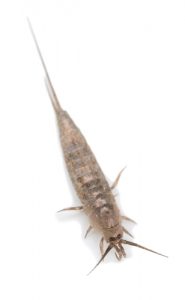What are Silverfish?
By Chris Williams on March 7, 2011.
Q. What are silverfish? I find them in the bathtub and they scare me.
A. Silverfish are primitive insects belonging to the Order Thysanura. Adults are about ½ inch in length and grayish in color. Their bodies have a flattened carrot-like shape with two long antennae near the head, and three long cerci, or tails coming off the back end, or abdomen. Both the antennae and cerci are used to smell and feel their environment. Tiny silver scales cover the body and sometimes shine in the light. If handled, the scales may rub off onto your fingers. Silverfish move in an undulating fashion, wiggling around like a fish, hence the common name. Their legs are tipped with tiny hooks that allow them to crawl and climb on almost any surface except smooth things like glass or porcelain sinks and tubs. Because they cannot climb out of these places, silverfish sometimes get trapped and are seen by homeowners. They do not sting or bite.
 Silverfish may cause damage to fabrics, books, wall paper paste, sizing, paper goods, and cereals. Silverfish naturally feed on miscellaneous cellulose and debris found in leaf litter and house dust. Silverfish are long lived and continue to molt, or shed their skin throughout their lives. Females lay eggs year round, and lay less than 100 eggs in their lifetime. Eggs are laid in cracks and hatch in roughly 28 weeks.
Silverfish may cause damage to fabrics, books, wall paper paste, sizing, paper goods, and cereals. Silverfish naturally feed on miscellaneous cellulose and debris found in leaf litter and house dust. Silverfish are long lived and continue to molt, or shed their skin throughout their lives. Females lay eggs year round, and lay less than 100 eggs in their lifetime. Eggs are laid in cracks and hatch in roughly 28 weeks.
Silver fish develop slowly with the young and adults closely resembling each other. Under ideal conditions, 72-80 degrees Farenheight, it takes 90-120 days from egg to mature adult. Adults may live up to 2 ½ years. Several species of silverfish are known to inhabit structures. Silverfish are found in the nests of insects, birds, mammals, under tree bark, and in leaf litter. Silverfish need moist environments and warm temperatures. Some species can live in areas that are not that moist such as attics, wall voids, behind shingles and wood shakes, and crawl spaces. I have seen them in almost all locations within a home when inspecting for insect activity. Seeing a silverfish once in a while is normal, as these little wigglers are everywhere. The presence of many and continuous silverfish may indicate a moisture problem. Houses with wood shake roofs and wood shingle siding seem to have an abundance of silverfish, and other insects taking advantage of the perfect habitat being provided. As conditions change, heating or cooling may cause silverfish to move into living spaces trying to find just the right place to live. Excessive dust build up will also lead to and increase in silverfish activity.
Control of silverfish is most easily done by reducing excessive humidity within the structure. Excessive moisture and humidity will not only provide ideal conditions for silverfish, but will be attractive to other pests such as carpenter ants, termites, booklice, not to mention mold and mildew concerns along with decay fungi. Moisture problems may include faulty gutters, exterior leaks, poor drainage, and roof leaks. All of these conditions should be addressed to limit structural damage from pests. Chemical treatments may be made in situations where silverfish are out of control, most cases involve changes in humidity. A pest control professional from Colonial Pest Control will be able to identify critical areas and inspect for insect activity and damage.